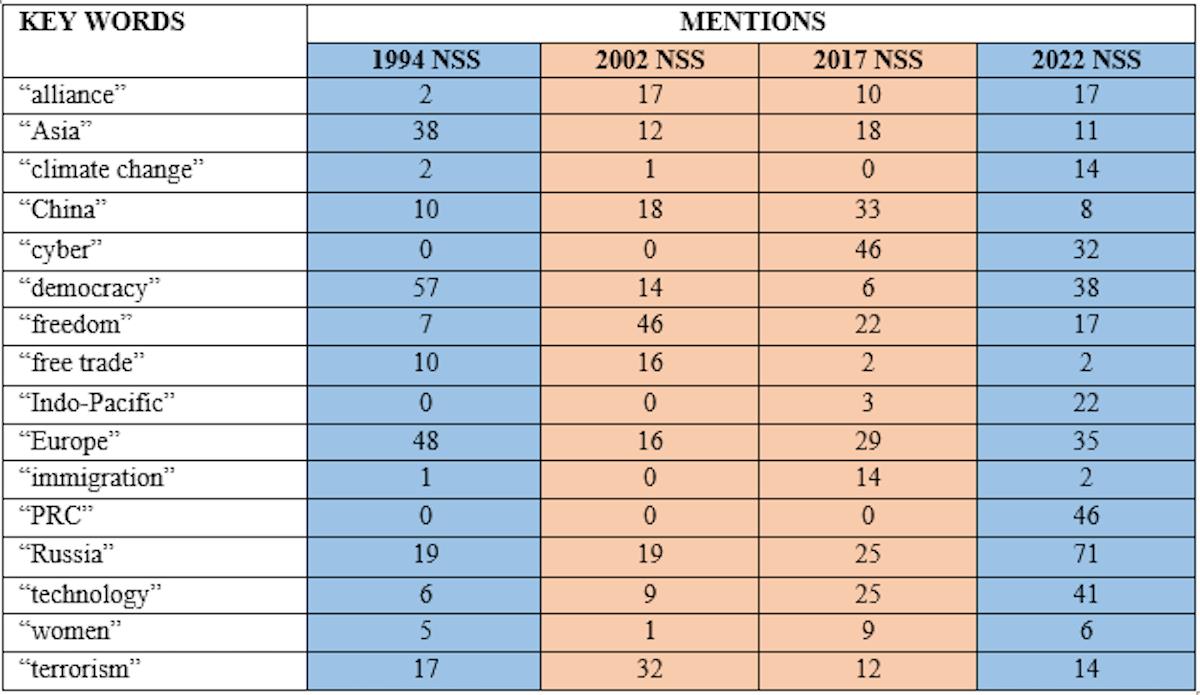(MENAFN- Asia Times) In America's new the major tension point for the Biden administration is knowing there is going to be a drawn-out ideological struggle with the People's Republic of China and Russia, while wanting to avoid the term“cold war” due to its long-term implications.
For those who read such documents regularly, there are few surprises in the latest iteration of the NSS, released October 12. Values are mentioned in the context of the United States' position in the world and vis-a-vis perceived adversaries such as Russia, Iran and the PRC.
The administration's lines of effort are listed in a typical format comprising ends, ways and means. There are also sections on each region of the world, where the strategies lay out more context.
But if one compares the Biden NSS with three other NSS documents released early in previous presidents' terms – under President Bill Clinton, under President George W Bush and under President Donald Trump – one can see the evolution of US national strategy over time.
By performing in all four documents word counts of key terms – such as“alliance,”“Asia,”“China,”“Russia,”“Europe,”“democracy,”“freedom,”“free trade” and“terrorism” – it is possible to discern an administration's priorities by how many mentions a key term gets in each document.
Seen across time, the variations in the use of these terms are indicative of differences and commonalities among the different administrations.

Table: Pacific Forum
For all the differences between the two parties in the US system and the yawning gulf of the culture wars, the four NSS documents analyzed are fairly similar. That's not because they are mundane documents written by bureaucrats.
Typically the efforts are led by the White House staff of each administration, who work hard to put the president's stamp on the US security posture. Rather, they are similar because the two parties – despite their domestic differences – share a common worldview and a similar conception of the US role within that world.
The four strategy documents all stress the importance of values and the democratic system to US foreign policy. Policymakers continue to stress the role of values in achieving the United States' paramount position and making the world a better place, although different NSS documents vary in how the administrations have expressed those values.
Democratic administrations seem to mention“democracy” more than“freedom,” while the reverse is true for Republican administrations. There are also differences in whether the US is determined to export or defend those values.
Freedoms of and freedoms from
The Biden NSS, despite a clear rejection of the cold-war concept, nevertheless draws heavily from US values language from the 1950s by dividing values into two forms – freedoms of liberalism (voting, political freedoms, free media) and freedoms from coercion and oppression.
This approach was prominent in President Truman's 1947 speech to Congress and makes sense because it widens the US appeal to global partners.
While the freedoms-of form would be attractive to fellow democratic liberal states in Europe, the freedoms-from form is more attractive to small and medium-sized non-democratic states whose sovereignty may be threatened by Moscow or Beijing.
If one is to fight a long ideological competition with a powerful authoritarian power, then one must frame that power by its coercive practices while having a broad base of support.
The 2022 NSS asserts that its goal is, at the systemic level, to create an order that is free, open, and prosperous. The terms echo those found in the , the language having been developed with allies such as Japan over the past decade to frame Chinese actions in the South China Sea, its Belt and Road Initiative and Russian efforts to destabilize and dominate Europe.
While previous strategies connect values with the overall international system, the Biden version follows that laid out in the Trump NSS by noting that China is also projecting its (authoritarian) values as it seeks to re-order the system.
Consequently, it lays out an architecture for out-competing the PRC across all domains, and this is the administration's priority. Despite this,“Russia” still gains 71 mentions compared with“China” and“the PRC,” which has 54 between them. The most likely explanation is Russia's renewed aggression against Ukraine, which dominates the section on Europe.
Speaking of Europe, one might expect to see the word“Europe” mentioned more than“Asia” or“Indo-Pacific” in earlier strategies but fading out as the PRC's rise became a more pressing issue for US strategists.
Indeed, this is borne out by analysis. Dropping from a high of 48 in the 1994 strategy,“Europe” is mentioned only 35 times in the 2022 NSS, while“Asia” and the“Indo-Pacific” account for 43 mentions.
The Biden NSS notes that the lines between domestic and foreign policy are blurring in the age of social media, insecure supply chains and data-related technologies.
The latter – including 5G, artificial intelligence, quantum and other emerging and critical technologies – have grown in importance as Xi Jinping has accelerated the Digital China strategy.
“Technology” is mentioned six times in 1994, nine times in 2002, 25 times in 2017, and 41 times in the 2022 NSS. This is a truly impressive marker of the importance of tech to the new era of competition.

Xi Jinping visits Wuhan Xinxin Semiconductor Manufacturing Corp in 2018. Photo: Wire China
The NSS also stresses the importance of allies, fairly common to most American strategic documents. However, the Biden administration's strategy mentions“alliances” 17 times – matched only by the document by the Bush administration, which was waging a global“war on terror” in 2002.
For those who track US trade policy, it will come as no surprise to see that“free trade” has also almost disappeared from the document, garnering only two mentions, a divergence between the United States and its allies.
This reflects the United States' continuing domestic debate over free trade agreements, sparked during the 2016 presidential election, which remains divisive among US policy elites.
Overall, the 2022 NSS is in line with those that came before it, but one can see the evolution towards a United States that must compete long-term with the PRC and Russia in the ideological, technological, military and economic domains, a United States that needs its allies to succeed.
One can also see a glimpse of the values language used by former president Truman – which became the Truman Doctrine and laid the foundations for the generational competition with the Soviet Union.
For those in the region who might view the United States as more obsessive about the values of freedom and democracy, the document goes out of its way to create a non-liberal definition of freedom – one of freedom from coercion, reminiscent of the backing of sovereignty that underpinned US support for Turkey (a non-democracy in 1947).
Surely, this is a definition that any regional state should support. If the United States can work with its partners and allies to make clear this freedom from coercion, with elements of open maritime access, is behind the term“free and open,” then the United States will begin to soften the resistance from regional friends and partners who do not share our democratic and liberal values.
On the other hand, the lack of an economic framework is a key concern, given China's pivotal role in the global economy and trade system – a challenge very different from that posed by a Cold War-era USSR.
John Hemmings ( ) is senior director of the Indo-Pacific Foreign and Security Policy Program at the Pacific Forum. This article, first published by the , is republished with permission.

























Comments
No comment